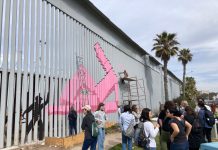San Diego is now ground zero for President Trump’s proposed border wall.
Select companies from around the nation, and some international firms, bidding to build the wall along the U.S.-Mexico border will be required to construct prototypes in San Diego, the U.S. Department of Homeland Security said.
The federal government isn’t saying exactly where bidders will display their designs, but a spokesman said San Diego was picked in part because of existing border work at Tijuana.
“(Customs and Border Patrol) identified San Diego . . . as the location to construct wall prototypes because of site accessibility to construct, and the ability to evaluate the wall as part of our larger, existing border infrastructure system,” wrote Ralph Desio, a border patrol spokesman, in an email to the Union-Tribune earlier this week.
Wall prototypes presented and constructed in San Diego must be 30 feet long. Bidders will also be required to demonstrate the quality of their construction to government analysts.
The bidding instructions said “up to 20” companies will be invited to build prototypes in San Diego. Winning firms must have a design that is 30 feet tall, can’t be climbed and is constructed to prevent digging below the wall for at least 6 feet. The side facing the U.S. should be “aesthetically pleasing in color,” the instructions said.
As of Wednesday night, roughly 25 San Diego County companies (out of 565 firms) had signed up as interested parties in the bid process, a precursor to putting in a proposal. They will compete against larger companies, such as Nebraska-based Kiewit.
Twenty-two local companies had signed up two weeks ago, but some firms have dropped out and others have joined since more detailed plans have emerged. The government has posted two contract notices centering on this project, with one being a more general search for “concept papers.”
At least one San Diego company, R.E. Staite Engineering, thinks it might have a leg up because the prototypes will be built in that city.
“For us, that’s called home court advantage,” said Ralph Hicks, the company’s vice president of governmental affairs, citing the difficulty other firms may have bringing materials across the country.
R.E. Staite has worked on major projects in the past, including cleanup of the Exxon Valdez oil spill, the effort to move an 880-foot container ship that ran aground in Ensenada, construction and dredging of the National City Marina Basin, and the foundation for the San Diego Convention Center.
While he would not divulge details of its design, Hicks said his firm was very enthusiastic about its proposal.
“We’re highly confident it will exceed the criteria the [request for proposals] calls for,” he said. “We’re not trying to meet the criteria. We’re trying to exceed it in every category.”
Some companies, however, signed up as interested parties as an ironic gesture. Studio Pali Fekete Architects in Culver City, which signed up last week, intended to submit a proposal to build a bridge instead of a barrier before deciding the paperwork wasn’t worth it.
“We were going to turn the wall on its side, if you will,” said Zoltan Pali, principal of the firm.
Leigh Jerrard, owner of ecological plumbing company Greywater Corps Inc. in Los Angeles, also indicated interest — but not in working on the project. A licensed contractor and architect, Jerrard said he signed up as an interested vendor to understand what the government was planning to do with the wall.
“I have no interest in designing or building anything that will further Trump’s agenda,” he said.
Work on the border wall could be split among multiple companies, and contracts could be extremely lucrative for firms that get a piece of the pie. Republicans in Congress have suggested the wall could cost $12 billion to $15 billion. An analysis published by MIT Technology Review said it could cost as much as $38 billion.
The U.S. budget Trump proposed last week — which would slash a multitude of other government programs — includes a request for $2.6 billion to build the border wall. That cash would be on top of an additional $1.5 billion the White House wants from Congress this year, bringing Trump’s total funding request to $4.1 billion for the wall so far.
Trump pledged during his campaign that Mexico would pay for construction of the wall, but his budget proposal did not include a way for that to happen.
The U.S.-Mexico border is about 2,000 miles long, about one-third of which is fenced. It’s unclear whether the wall would be built along stretches that already have fencing.
Companies have until Wednesday to turn in their bids.
Terrence Payne, chief executive of TMM Enterprises Group Inc., said many of the large contractors his firm supplies anticipate working on the border wall. The Los Angeles-based TMM has just three employees and has a supply division that sells tools and materials such as steel and electrical cables. He said he wants to find out more about how small and minority-owned businesses fit into the wall project.
“I understand that project is extremely polarizing,” he said. “Some projects you don’t like, but you have to do your job and sell the product. In the world of supply, you follow the large projects.”
The project is indeed polarizing. Two San Francisco supervisors introduced legislation this week that would bar the city from contracting with companies that bid on the wall, regardless if they actually win, said the San Francisco Chronicle. And some state Assembly members have introduced Assembly Bill 946 that would divest pension fund holdings in companies that win contracts to build the wall, reported Bloomberg.
James Fletcher, owner of James Fletcher Construction in Chula Vista, said last week that he was still trying to figure out exactly what the federal government wants.
A concrete wall wouldn’t make much sense, he said: What with footings, steel reinforcement bars and other expenses, some portions of a 30-foot-tall concrete structure could cost up to $20 million a mile.
“There are other things being built that are more cost-effective and just as good,” he said, reasoning that a steel wall would make the most sense.
Fletcher’s company, which has registered as an interested vendor on the border wall, has roughly a dozen employees but can increase to up to 40 if needed. It recently did concrete work and grade beams for a project at Naval Air Station North Island.
Mike Mclaughlin, owner of Greenfield Fence in Oceanside with 150 employees, said a lot of the hoopla over the wall is unwarranted because of so much recent construction at the border.
“This is nothing new,” he said. “They have been building this wall for close to 15 years.”
One of the most enthusiastic bidders is Rod Hadrian, owner of Tridipanel in Carlsbad. His company uses several layers of wire mesh welded together and attached to polystyrene foam, a type of plastic, which is then covered in cement.
“It’s lightweight, durable and strong as hell,” Hadrian said. “It’s what they need.”
Times staff writers Samantha Masunaga and Brian Bennett contributed to this report.





